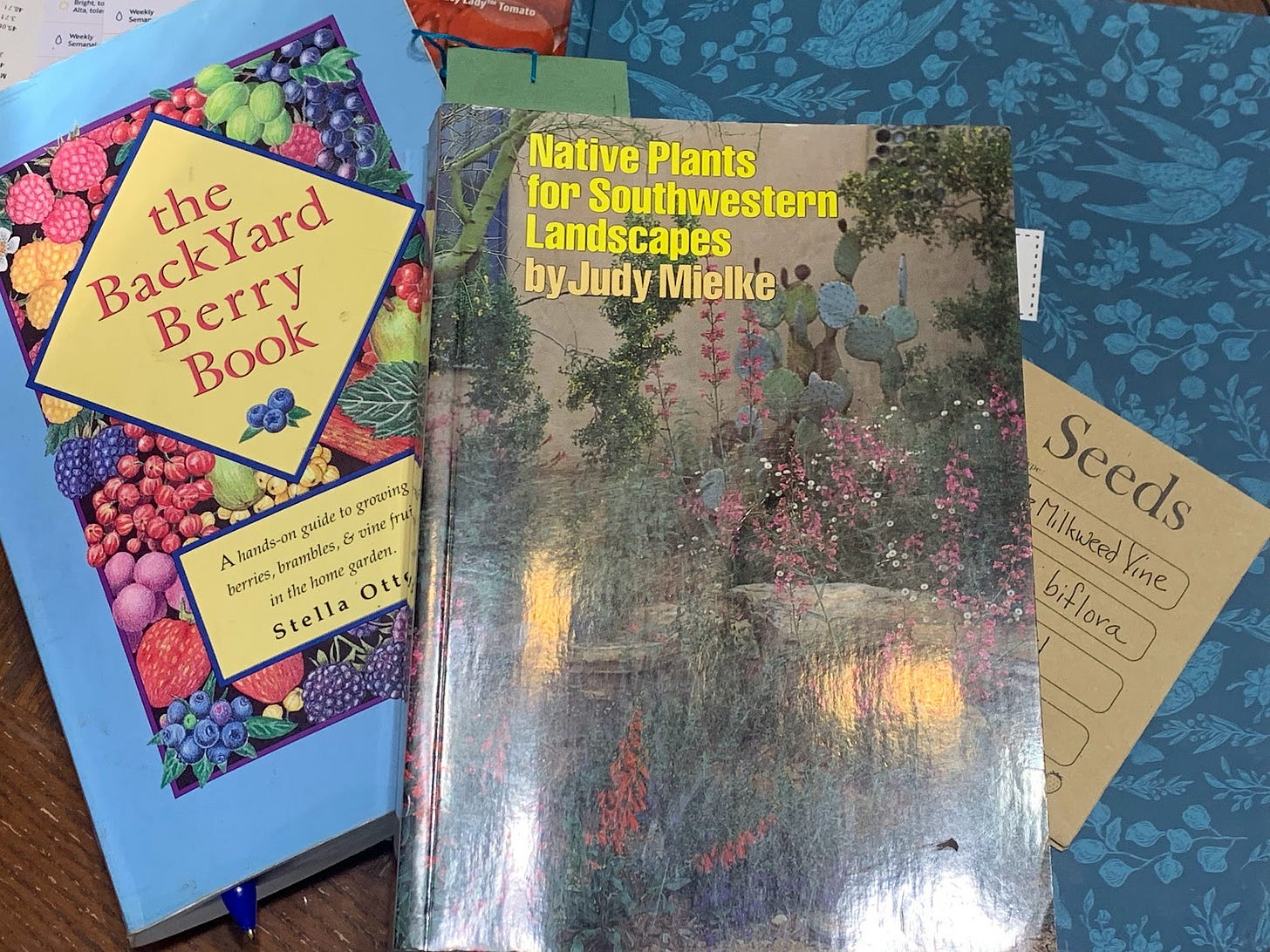Two garden books this week. One is a book I grew up with, realized recently I no longer had a copy of, and acquired again because… well, I’ll get into that. The other is part of my ongoing research project into creating a successful cottage garden here in North Texas on the dry line. As a note, any books you buy through a link to Amazon do get me a little bit of support for the blog and garden monies.
The Backyard Berry Book is all you want or need to get started growing berries on a small to medium scale. My berries will be woven through the food forest I’m developing on our town lot, integral to the hedgerow around the front yard, and tucked into guilds elsewhere. Even though I have decades of experience in berry cultivation and harvest, I still feel this book is going to be an asset to have on hand. I like to read through my garden books during winter, refreshing my memory on things, or learning something I overlooked before (in re-reading texts).
I first went looking on my shelf for this book when I had been searching for currant hardiness zones, and the internet results were wildly variable. When the warm end of the hardy zone ranges from 5 to 8, there’s something wrong. This is when having a book is really handy! Also, something I’ve noted recently is that searching for an answer, then having to verify the source, takes me longer than grabbing a book off the shelf and hitting the index to find an answer I can trust the first time. Obviously, you want to check your books, but that’s a once-and-done, then you can go get it in confidence.
The Backyard Berry Book covers everything from soil preparation, planting, pruning, and pest control. Then the author goes into the specifics for caring for types of berries: brambles (raspberries, blackberries, and others), blueberries, lingonberries, currants and gooseberries. Then vines, with a few chapters devoted to various kinds of grapes, and wrapping up with kiwifruit.
One drawback of a book (this one is copyright 1995) is that it doesn’t update to reflect newer kinds of berries that come up in popularity. However, if you use this as a basis, it will help with things like Aronia, Jujube, and Honeyfruit which are the new hotness, at least getting you pointed in the right direction. I will also say that this book is very focused on the Midwestern and Northeastern regions of the United States, leaving my area and places west of me a bit out of it (although the Pacific Northwest gardens can grow all of the things, but then they always can, lucky!) .
Overall, if you are plotting out a food forest, doing permaculture, and have more than a balcony to garden on, this book will have useful information for you, and I recommend you scoop up a used copy to add to your personal garden library. Unless of course, you don’t like berries, in which case I don’t know what to say to you!
The second book this week is a much more specialized niche for the gardener and landscaper. Where I live is considered to be ‘on the dry line’ an invisible but palpable barrier running up the center of the continent (more-or-less). It is a fascinating meteorological phenomenon, but what it means practically for a gardener in the Texoma region is that we are one foot in the wetter eastern region, and one in the dry fringes of the Southwestern desert areas. I can grow many things I could elsewhere in the Midwest, but there are also things like the currants I referenced above which will struggle due to the relative heat and dryness of my garden.
In aid of finding plants that will be happier to my area, being native, I have found a few books which may not apply directly to me, but will help me get ideas. Native Plants for Southwestern Landscapes (1993) by Judy Mielke is one of them. I’ve really enjoyed it. She is focused on plants for the deserts which stretch from Texas over to California, but some of them will grow for me, and I’ve seen in the wild near my home. The book is laid out more like a field guide, with encyclopedic entries for each plant, and color photos interspersed between pages of detailed descriptions and planting suggestions. I appreciate the inclusion of temperature lows the plant can tolerate, as this hints me towards the ones I can keep. Some are from much further south. Someone in the Hill Country of Texas could grow almost all of these, which makes sense when you see the book was published by University of Texas Austin.
It is a lovely book, and I’m very pleased with it. She highlights plants with good photos of the overall growth habit, and practical landscape placement suggestions to get the best out of fragrance, texture, and avoidance of thorns. It’s not really intended to be read through like a novel, but I have been doing that, and enjoying learning so much about some lovely plants I look forward to finding in real life. Sourcing the ones I want may be tricky, as there are few native plant nurseries around. I have one in the nearby small city, which I am very lucky to have, but they have limited stock. There’s another in Oklahoma City, which I plan to visit sometime soon. I am hopeful of finding others in all good time. If you live in a dry region and want to have a beautiful garden while keeping water use to a minimum, I can recommend this book for helping you plan and improve your landscape and gardens.






I recently noted that the USDA had adjusted the Zones in 2023. So an older source may show an area colder than is currently projected. Here is a link to the zone maps. https://planthardiness.ars.usda.gov/